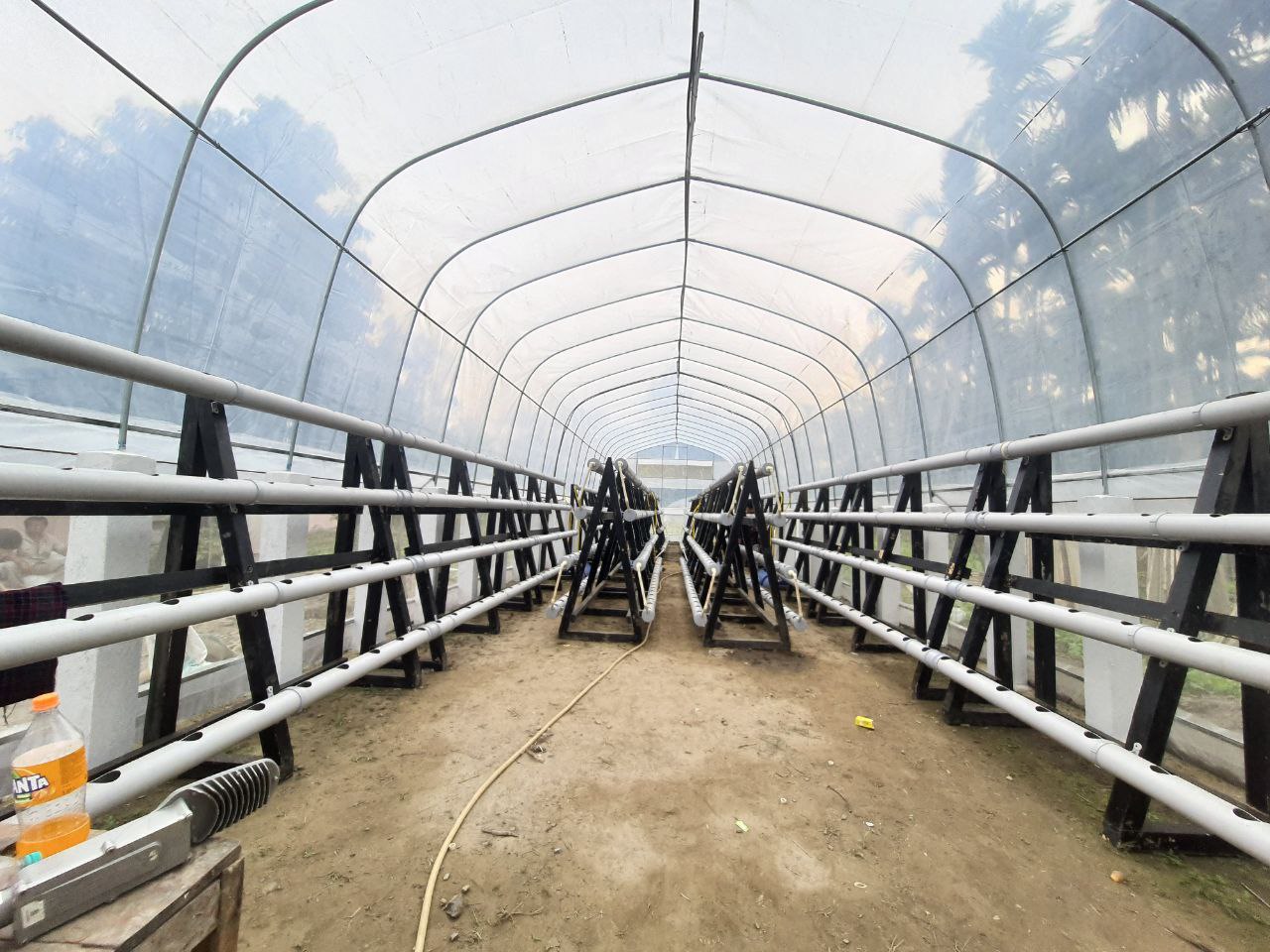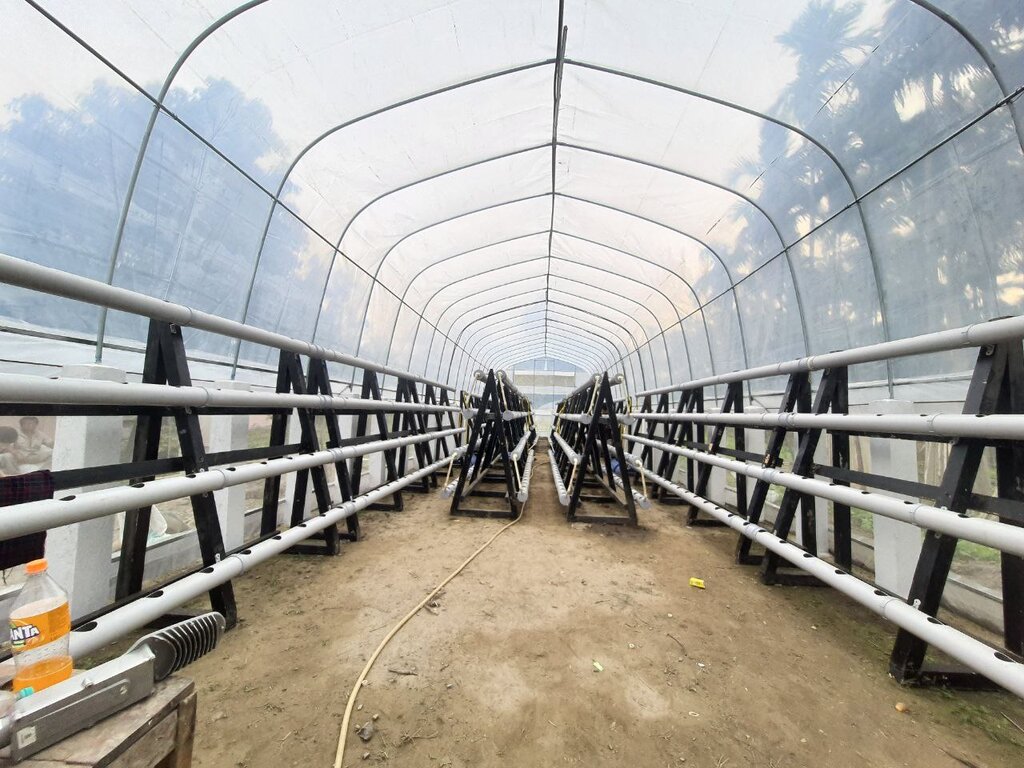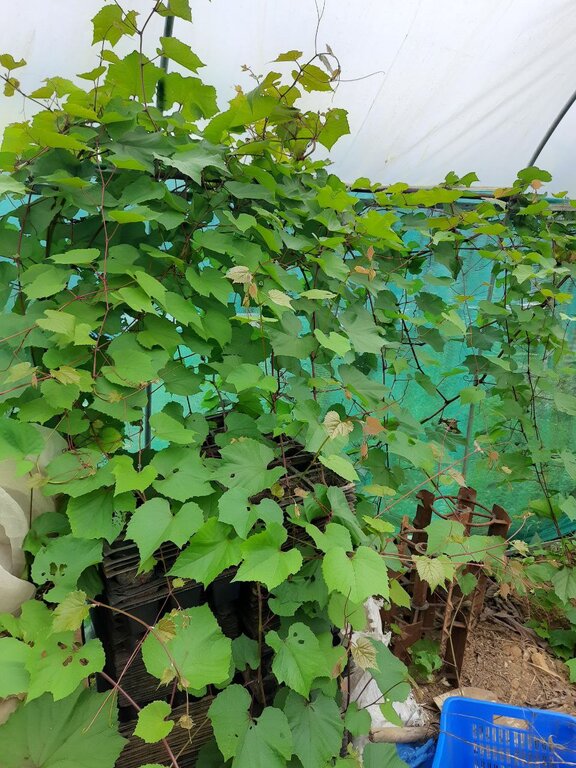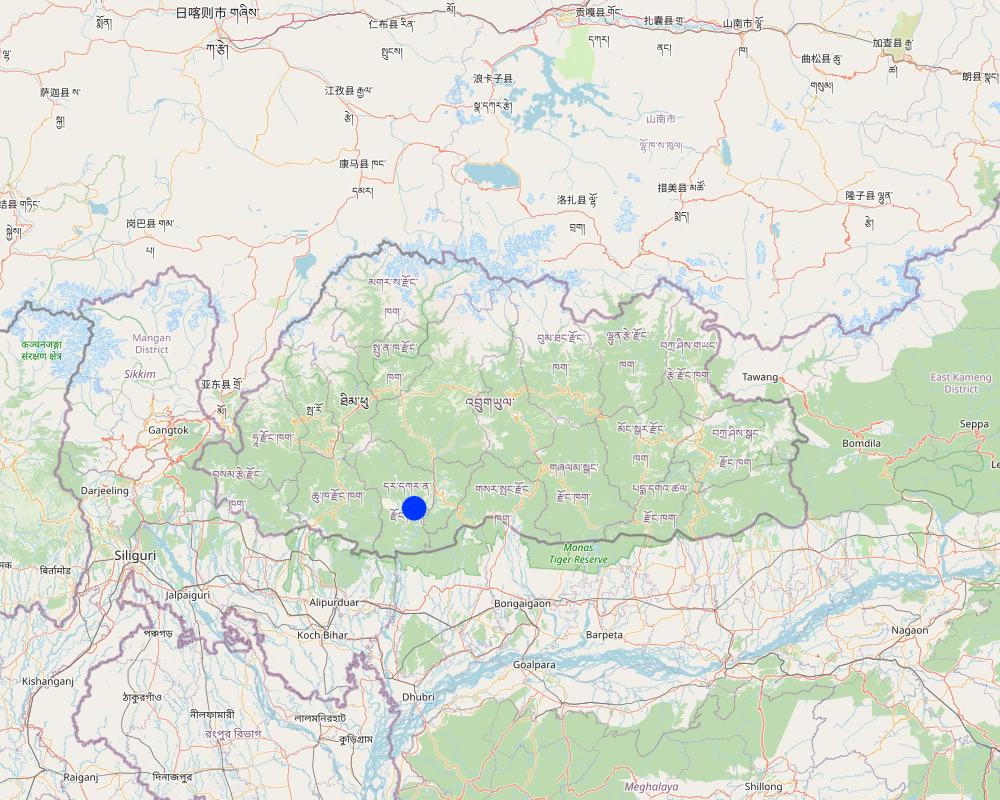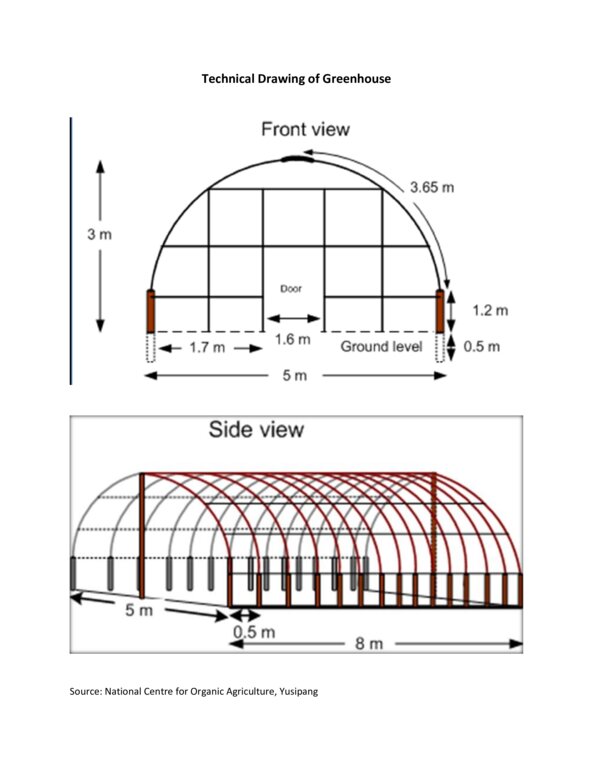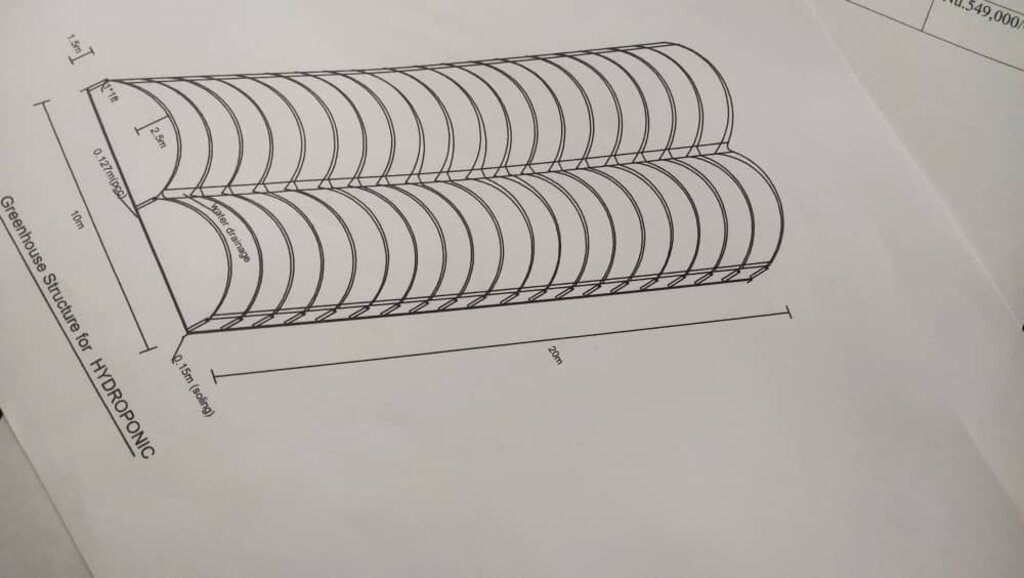Protected Agriculture for High Value Crops [ภูฏาน]
- ผู้สร้างสรรค์:
- การอัพเดท:
- ผู้รวบรวม: Nima Dolma Tamang
- ผู้เรียบเรียง: Haka Drukpa
- ผู้ตรวจสอบ: William Critchley, Rima Mekdaschi Studer
technologies_6846 - ภูฏาน
ดูส่วนย่อย
ขยายทั้งหมด ย่อทั้งหมด1. ข้อมูลทั่วไป
1.2 รายละเอียดที่ติดต่อได้ของผู้รวบรวมและองค์กรที่เกี่ยวข้องในการประเมินและการจัดเตรียมทำเอกสารของเทคโนโลยี
วิทยากรหลัก
ผู้ใช้ที่ดิน:
Narayan Abi
Abimanyum Farm
ภูฏาน
ชื่อของโครงการซึ่งอำนวยความสะดวกในการทำเอกสารหรือการประเมินเทคโนโลยี (ถ้าเกี่ยวข้อง)
Strengthening national-level institutional and professional capacities of country Parties towards enhanced UNCCD monitoring and reporting – GEF 7 EA Umbrella II (GEF 7 UNCCD Enabling Activities_Umbrella II)ชื่อขององค์กรซึ่งอำนวยความสะดวกในการทำเอกสารหรือการประเมินเทคโนโลยี (ถ้าเกี่ยวข้อง)
National Soil Services Centre, Department of Agriculture, Ministry of Agriculture & Livestock (NSSC) - ภูฏาน1.3 เงื่อนไขการใช้ข้อมูลที่ได้บันทึกผ่านทาง WOCAT
ผู้รวบรวมและวิทยากรหลักยอมรับเงื่อนไขเกี่ยวกับการใช้ข้อมูลที่ถูกบันทึกผ่านทาง WOCAT:
ใช่
1.4 การเปิดเผยเรื่องความยั่งยืนของเทคโนโลยีที่ได้อธิบายไว้
เทคโนโลยีที่ได้อธิบายไว้นี้เป็นปัญหาของความเสื่อมโทรมโทรมของที่ดินหรือไม่ จึงไม่ได้รับการยอมรับว่าเป็นเทคโนโลยีเพื่อการจัดการที่ดินอย่างยั่งยืน:
ไม่ใช่
1.5 Reference to Questionnaire(s) on SLM Approaches (documented using WOCAT)
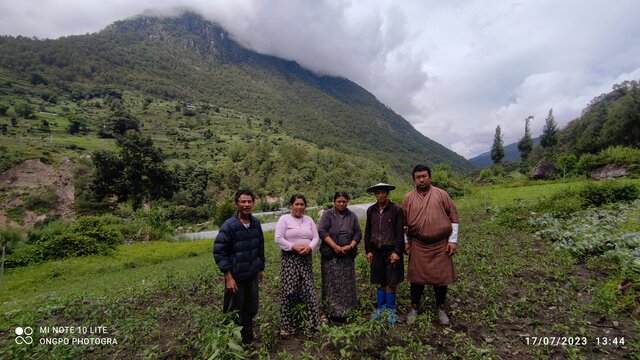
Enhancing Agricultural Production Through Fallow Land Reversion [ภูฏาน]
The approach is to enhance production of local vegetables and fruits through fallow land restoration - under a group established for the purpose.
- ผู้รวบรวม: Nima Dolma Tamang
2. การอธิบายลักษณะของเทคโนโลยี SLM
2.1 การอธิบายแบบสั้น ๆ ของเทคโนโลยี
คำจำกัดความของเทคโนโลยี:
Protected agriculture (controlled environment agriculture) is the use of technology to modify the growing environment for crops to extend the growing period and increase yields. It can include greenhouses, shade nets or polytunnels. This technology is moderately expensive therefore it is used only for the cultivation of high-value crops and raising seedlings in winter.
2.2 การอธิบายแบบละเอียดของเทคโนโลยี
คำอธิบาย:
Protected agriculture, also known as controlled environment agriculture, refers to the practice of growing crops within an enclosed structure that provides controlled environmental conditions. There are various structures that can be employed, such as greenhouses, shade nets, polytunnels and glasshouses. This documentation focuses on greenhouses. These are commonly used for cultivating high-value crops that yield a higher economic return per unit area compared to traditional field crops. Technical specification for a 20 m x 5 m greenhouse set consists of a galvanized tubular frame, two doors, UV stabilized 120 GSM cross-laminated clear plastic sheet, channels and a nylon belt for holding the plastic sheet. Construction activities include clearing, levelling the ground and ensuring drainage. Installation of water lines, electrical connections, heating systems and ventilation systems is required.
Greenhouses are typically designed with a framework made of materials like metal, wood, or PVC. The structure must be sturdy enough to support covering materials and withstand environmental loads such as wind and snow. Coverings are transparent or translucent materials that allow sunlight to enter the structure. Common options include glass, polycarbonate panels, or plastic film. The choice of covering material depends on factors such as light transmission, insulation properties, durability, and cost. Greenhouses require adequate ventilation to control temperature, humidity, and air circulation. Vents, louvres, or roll-up side walls can be used to regulate airflow and prevent heat buildup. Exhaust fans or natural ventilation methods help remove excess heat, humidity, and carbon dioxide from the structure. Efficient irrigation systems, such as drip irrigation, and micro-sprinklers, are used to deliver water directly to plants' root zones. Raised beds of 1.2 m width and 30 cm height and planting distance of 60 cm are applied for (for example) watermelon.
Greenhouses allow for the cultivation of plants throughout the year, regardless of the external weather. By maintaining a stable and favourable climate inside, growers can start plants earlier in the spring, extend the growing season into the fall, or even grow plants year-round in certain regions. It shields plants from adverse weather conditions such as frost, heavy rain, wind, or hail, which can damage or destroy crops. Greenhouses provide a physical barrier that safeguards plants from external threats, minimizing the risk of disease, pests, and other environmental stresses.
Greenhouses provide a range of benefits and impacts, including increased food production by extending the growing season and improving food security. They produce higher crop yields by providing optimal growing conditions and conserving water through efficient irrigation systems. Greenhouses also contributes to reduced pesticide use, energy efficiency, local and seasonal produce, employment opportunities, research and innovation, and serves as an attractive space for recreation and education. Overall, greenhouses offer sustainable and efficient solutions for agriculture while enhancing environmental stewardship and community well-being.
Protected agriculture through the use of greenhouses offers land users the ability to control environmental factors, leading to optimal conditions for plant growth and higher crop yields compared to open-field cultivation. It protects from adverse weather conditions, reducing crop losses due to frost, rain, or wind. Additionally, the controlled environment minimizes the risk of pests and diseases, resulting in fewer losses and reduced reliance on pesticides. Overall, greenhouses enhance productivity, profitability, and sustainability for land users. On the other hand, setting up a greenhouse requires a significant initial investment, including the construction or purchase of the structure, equipment, and environmental control systems. Operating a greenhouse involves ongoing costs for utilities, maintenance, and replacement of equipment, which can impact profitability. The cost can be reduced by establishing a low cost greenhouse with locally available materials such as bamboo.
2.3 รูปภาพของเทคโนโลยี
2.4 วีดีโอของเทคโนโลยี
ความคิดเห็น/อธิบายสั้นๆ:
https://www.youtu.be/i8izu3PmQRE
This link provides poly house construction basics video prepared by ARDC Bajo officials and JICA experts of Integrated Horticulture Promotion Project
วันที่:
01/11/2020
สถานที่:
Agriculture Research and Development Sub Centre Tsirang
ชื่อผู้ถ่ายวีดีโอ:
JICA Experts and ARDC Bajo Officials
2.5 ประเทศภูมิภาค หรือสถานที่ตั้งที่เทคโนโลยีได้นำไปใช้และได้รับการครอบคลุมโดยการประเมินนี้
ประเทศ:
ภูฏาน
ภูมิภาค/รัฐ/จังหวัด:
Dagana Dzongkhag
ข้อมูลจำเพาะเพิ่มเติมของสถานที่ตั้ง :
Tsendagang Gewog
ระบุการกระจายตัวของเทคโนโลยี:
- ใช้ ณ จุดที่เฉพาะเจาะจงหรือเน้นไปยังบริเวณพื้นที่ขนาดเล็ก
Is/are the technology site(s) located in a permanently protected area?
ไม่ใช่
แสดงความคิดเห็น:
It is leased land and does not fall under a permanently protected area.
Map
×2.6 วันที่การดำเนินการ
ระบุปีที่ใช้:
2020
2.7 คำแนะนำของเทคโนโลยี
- Through other farmers
3. การจัดประเภทของเทคโนโลยี SLM
3.1 วัตถุประสงค์หลักของเทคโนโลยี
- ปรับปรุงการผลิตให้ดีขึ้น
- ลดความเสี่ยงของภัยพิบัติ
- ชะลอการเปลี่ยนแปลงภูมิอากาศของโลกและผลกระทบ
- สร้างผลกระทบทางด้านเศรษฐกิจที่เป็นประโยชน์
- To improve livelihood
3.2 ประเภทของการใช้ที่ดินในปัจจุบันที่ได้นำเทคโนโลยีไปใช้
Land use mixed within the same land unit:
ใช่
Specify mixed land use (crops/ grazing/ trees):
- วนเกษตร (Agroforestry)

พื้นที่ปลูกพืช
- การปลูกพืชล้มลุกอายุปีเดียว
- การปลูกพืชยืนต้นที่ไม่มีเนื้อไม้
- การปลูกไม้ยืนต้น ไม้พุ่ม
Annual cropping - Specify crops:
- legumes and pulses - beans
- vegetables - melon, pumpkin, squash or gourd
- vegetables - other
- Chilli
Perennial (non-woody) cropping - Specify crops:
- banana/plantain/abaca
- flower crops - perennial
Tree and shrub cropping - Specify crops:
- tree nuts (brazil nuts, pistachio, walnuts, almonds, etc.)
จำนวนของฤดูเพาะปลูกต่อปี:
- 2
Is intercropping practiced?
ใช่
If yes, specify which crops are intercropped:
Watermelon and zucchini are intercropped
Is crop rotation practiced?
ใช่
ถ้าใช่ ระบุ:
Watermelon is followed by chilli or beans cultivation on the same land
3.3 Has land use changed due to the implementation of the Technology?
Has land use changed due to the implementation of the Technology?
- Yes (Please fill out the questions below with regard to the land use before implementation of the Technology)
Land use mixed within the same land unit:
ไม่ใช่

ป่า/พื้นที่ทำไม้
- ป่ากึ่งธรรมชาติ / พื้นที่ทำไม้
- Natural forest
Are the trees specified above deciduous or evergreen?
- evergreen
แสดงความคิดเห็น:
The land is a cleared settlement from indigenous subtropical forest. Land use changed from subtropical forest to the agroforestry system where few native trees were retained with fruit trees and crops cultivated.
3.4 การใช้น้ำ
การใช้น้ำของที่ดินที่มีการใช้เทคโนโลยีอยู่:
- การชลประทานแบบเต็มรูปแบบ
แสดงความคิดเห็น:
Protected agriculture - especially greenhouses - depends on full irrigation with a drip irrigation system.
3.5 กลุ่ม SLM ที่ตรงกับเทคโนโลยีนี้
- ระบบหมุนเวียน (การปลูกพืชหมุนเวียน การพักดิน การเกษตรแบบไร่เลื่อนลอย)
- การปรับปรุงพันธุ์พืชหรือพันธุ์สัตว์ต่าง ๆ
- การจัดการด้านชลประทาน (รวมถึงการลำเลียงส่งน้ำ การระบายน้ำ)
3.6 มาตรการ SLM ที่ประกอบกันเป็นเทคโนโลยี

มาตรการจัดการพืช
- A1: พืช/สิ่งปกคลุมดิน
- A2: อินทรียวัตถุในดิน/ความอุดมสมบูรณ์ในดิน

มาตรการอนุรักษ์ด้วยโครงสร้าง
- S1: คันดิน
- S11: อื่น ๆ

มาตรการอนุรักษ์ด้วยการจัดการ
- M1: การเปลี่ยนรูปแบบของการใช้ประโยชน์ที่ดิน
แสดงความคิดเห็น:
For the introduction of the technology, excavated or cut-and-fill bench terraces were built to install greenhouses.
3.7 รูปแบบหลักของการเสื่อมโทรมของที่ดินที่ได้รับการแก้ไขโดยเทคโนโลยี

การกัดกร่อนของดินโดยน้ำ
- Wt (Loss of topsoil): การสูญเสียดินชั้นบนหรือการกัดกร่อนที่ผิวดิน

การกัดกร่อนของดินโดยลม
- Et (Loss of topsoil): การสูญเสียดินชั้นบน

การเสื่อมโทรมของดินทางด้านชีวภาพ
- Bc (Reduction of vegetation cover): การลดลงของจำนวนพืชที่ปกคลุมดิน
- Bp (Increase of pests/diseases): การเพิ่มขึ้นของศัตรูพืชและโรคพืช

การเสื่อมโทรมของน้ำ
- Hs (Change in quantity of surface water): การเปลี่ยนแปลงปริมาณของน้ำที่ผิวดิน
3.8 การป้องกัน การลดลง หรือการฟื้นฟูความเสื่อมโทรมของที่ดิน
ระบุเป้าหมายของเทคโนโลยีกับความเสื่อมโทรมของที่ดิน:
- ป้องกันความเสื่อมโทรมของที่ดิน
4. ข้อมูลจำเพาะด้านเทคนิค กิจกรรมการนำไปปฏิบัติใช้ ปัจจัยนำเข้า และค่าใช้จ่าย
4.1 แบบแปลนทางเทคนิคของเทคโนโลยี
ข้อมูลจำเพาะด้านเทคนิค (แบบแปลนทางเทคนิคของเทคโนโลยี):
The technical drawing provided is for the low-cost greenhouse (Made up of bamboo). Generally, the length of a commercial greenhouse is 10 or 20 m and the width of 5 m. The greenhouse can be modified based on the crop to be cultivated. Additional facilities such as drip irrigation set, blower, fan, cooling pad and exhaust fan, temperature sensors are added modify the environment.
ผู้เขียน:
National Centre for Organic Agriculture, Yusipang
ข้อมูลจำเพาะด้านเทคนิค (แบบแปลนทางเทคนิคของเทคโนโลยี):
Technical details for setting up 5m by 20m double poly house protected structure
ผู้เขียน:
ARDC Bajo
วันที่:
01/07/2020
4.2 ข้อมูลทั่วไปเกี่ยวกับการคำนวณปัจจัยนำเข้าและค่าใช้จ่าย
ให้ระบุว่าค่าใช้จ่ายและปัจจัยนำเข้าได้รับการคำนวณอย่างไร:
- ต่อพื้นที่ที่ใช้เทคโนโลยี
ระบุขนาดและหน่วยพื้นที่:
3.75 acres
อื่นๆ หรือสกุลเงินประจำชาติ (ระบุ):
Ngultrum (Nu.)
If relevant, indicate exchange rate from USD to local currency (e.g. 1 USD = 79.9 Brazilian Real): 1 USD =:
79.0
ระบุค่าเฉลี่ยของค่าจ้างในการจ้างแรงงานต่อวัน:
500
4.3 กิจกรรมเพื่อการจัดตั้ง
| กิจกรรม | Timing (season) | |
|---|---|---|
| 1. | Clearing of vegetations | Winter |
| 2. | Agriculture land development | Winter |
| 3. | Field preparation | Winter |
| 4. | Installation of greenhouse and other structure | Winter |
| 5. | Sowing and plantation of crops and fruits (especially late winter crops) | Winter |
แสดงความคิดเห็น:
The installation of a greenhouse can be done in any season. However, the most preferred time for the installation is in winter when the crops standing in the field are minimal and the land users are not involved in other farming activities such as paddy cultivation.
4.4 ค่าใช้จ่ายของปัจจัยนำเข้าที่จำเป็นสำหรับการจัดตั้ง
| ปัจจัยนำเข้า | หน่วย | ปริมาณ | ค่าใช้จ่ายต่อหน่วย | ค่าใช้จ่ายทั้งหมดต่อปัจจัยนำเข้า | %ของค่าใช้จ่ายที่ก่อให้เกิดขึ้นโดยผู้ใช้ที่ดิน | |
|---|---|---|---|---|---|---|
| แรงงาน | Farm establishment | Number | 30.0 | 500.0 | 15000.0 | 100.0 |
| แรงงาน | Installation of structure and plantation | Number | 15.0 | 500.0 | 7500.0 | 100.0 |
| อุปกรณ์ | Excavator (farm establishment) | Number of days | 12.0 | 24000.0 | 288000.0 | 100.0 |
| อุปกรณ์ | Power tiller | Per hour | 16.0 | 250.0 | 4000.0 | 50.0 |
| วัสดุด้านพืช | Dragon fruit | Per sapling | 300.0 | 50.0 | 15000.0 | |
| วัสดุด้านพืช | Watermelon seed | Per packet | 1.0 | 2700.0 | 2700.0 | |
| วัสดุสำหรับก่อสร้าง | Greenhouse | Number | 6.0 | 80000.0 | 480000.0 | 20.0 |
| วัสดุสำหรับก่อสร้าง | Dragon fruit staking | Number | 39.0 | 700.0 | 27300.0 | 100.0 |
| ค่าใช้จ่ายทั้งหมดของการจัดตั้งเทคโนโลยี | 839500.0 | |||||
| Total costs for establishment of the Technology in USD | 10626.58 | |||||
ถ้าผู้ใช้ที่ดินรับภาระน้อยกว่า 100% ของค่าใช้จ่าย ให้ระบุว่าใครเป็นผู้รับผิดชอบส่วนที่เหลือ:
Royal Government of Bhutan (RGoB)
แสดงความคิดเห็น:
For a greenhouse it costs Nu. 80000. Therefore, the total cost of six green houses that are available at the farm is Nu. 480000 (USD 5790). For the greenhouse, 80% is borne by the RGoB. However, for the overall establishment major costs were borne by the land user and a minimal cost was part of the subsidy/fund support from RGoB as shown in the table above. The land user has 4.9 acre of which 3.75 acre is cultivated and 0.11 acre is under protected agriculture.
4.5 การบำรุงรักษาสภาพหรือกิจกรรมที่เกิดขึ้นเป็นประจำ
แสดงความคิดเห็น:
The land user haven't carry out any maintenance due to the recent establishment of the farm. However, there is likely to have a maintenance cost of Nu. 5000 (USD 289) for the greenhouses and overall recurrent cost of Nu. 41975 (USD 506) per annum.
4.6 ค่าใช้จ่ายของปัจจัยนำเข้าและกิจกรรมที่เกิดขึ้นเป็นประจำที่ต้องการการบำรุงรักษา (ต่อปี)
แสดงความคิดเห็น:
No maintenance has been carried out
4.7 ปัจจัยสำคัญที่สุดที่มีผลกระทบต่อค่าใช้จ่าย
ปัจจัยสำคัญที่สุดที่มีผลกระทบต่อค่าใช้จ่ายต่างๆ:
Infrastructure and machinery.
5. สิ่งแวดล้อมทางธรรมชาติและของมนุษย์
5.1 ภูมิอากาศ
ฝนประจำปี
- < 250 ม.ม.
- 251-500 ม.ม.
- 501-750 ม.ม.
- 751-1,000 ม.ม.
- 1,001-1,500 ม.ม.
- 1,501-2,000 ม.ม.
- 2,001-3,000 ม.ม.
- 3,001-4,000 ม.ม.
- > 4,000 ม.ม.
เขตภูมิอากาศเกษตร
- กึ่งชุ่มชื้น
The area falls under a humid subtropical and warm subtropical zone among the six agro-ecological zones of Bhutan.
5.2 สภาพภูมิประเทศ
ค่าเฉลี่ยความลาดชัน:
- ราบเรียบ (0-2%)
- ลาดที่ไม่ชัน (3-5%)
- ปานกลาง (6-10%)
- เป็นลูกคลื่น (11-15%)
- เป็นเนิน (16-30%)
- ชัน (31-60%)
- ชันมาก (>60%)
ธรณีสัณฐาน:
- ที่ราบสูง/ที่ราบ
- สันเขา
- ไหล่เขา
- ไหล่เนินเขา
- ตีนเนิน
- หุบเขา
ระดับความสูง:
- 0-100 เมตร
- 101-500 เมตร
- 501-1,000 เมตร
- 1,001-1,500 เมตร
- 1,501-2,000 เมตร
- 2,001-2,500 เมตร
- 2,501-3,000 เมตร
- 3,001-4,000 เมตร
- > 4,000 เมตร
ให้ระบุถ้าเทคโนโลยีได้ถูกนำไปใช้:
- ไม่เกี่ยวข้อง
5.3 ดิน
ค่าเฉลี่ยความลึกของดิน:
- ตื้นมาก (0-20 ซ.ม.)
- ตื้น (21-50 ซ.ม.)
- ลึกปานกลาง (51-80 ซ.ม.)
- ลึก (81-120 ซ.ม.)
- ลึกมาก (>120 ซ.ม.)
เนื้อดิน (ดินชั้นบน):
- หยาบ/เบา (ดินทราย)
เนื้อดินล่าง (> 20 ซ.ม.ต่ำจากผิวดิน):
- หยาบ/เบา (ดินทราย)
อินทรียวัตถุในดิน:
- สูง (>3%)
(ถ้ามี) ให้แนบคำอธิบายเรื่องดินแบบเต็มหรือระบุข้อมูลที่มีอยู่ เช่น ชนิดของดิน ค่า pH ของดินหรือความเป็นกรดของดิน ความสามารถในการแลกเปลี่ยนประจุบวก ไนโตรเจน ความเค็ม เป็นต้น:
Moisture content 3.31%, organic matter 5.03%, organic carbon 2.92%, pH 5.67, electrical conductivity 337.67 µs/cm, nitrogen 0.15%, phosphorus 0.09 ppm, potassium 123.07 mg/100ml, texture sand clay loam.
The soil analysis was conducted at the Science Laboratory of College of Natural Resources, Royal University of Bhutan, Lobesa, Punakha.
The soil data shared under the section 5.2 is for the growing media used inside the greenhouse. Land user adds organic manure to the existing topsoil which is used as a growing media.
5.4 ความเป็นประโยชน์และคุณภาพของน้ำ
น้ำไหลบ่าที่ผิวดิน:
ปานกลาง
คุณภาพน้ำ (ที่ยังไม่ได้บำบัด):
เป็นน้ำเพื่อการดื่มที่ไม่ดี (จำเป็นต้องได้รับการบำบัด)
Water quality refers to:
surface water
ความเค็มของน้ำเป็นปัญหาหรือไม่:
ไม่ใช่
กำลังเกิดน้ำท่วมในพื้นที่หรือไม่:
ไม่ใช่
ความคิดเห็นและข้อมูลจำเพาะเพิ่มเติมเรื่องคุณภาพและปริมาณน้ำ:
There is a water shortage during the winter season.
5.5 ความหลากหลายทางชีวภาพ
ความหลากหลายทางชนิดพันธุ์:
- ปานกลาง
ความหลากหลายของแหล่งที่อยู่:
- ปานกลาง
ความคิดเห็นและข้อมูลจำเพาะเพิ่มเติมของความหลากหลายทางชีวภาพ:
The species and habitat diversity in the questions above are referred to the farm and not inside the greenhouse.
5.6 ลักษณะของผู้ใช้ที่ดินที่นำเทคโนโลยีไปปฏิบัติใช้
อยู่กับที่หรือเร่ร่อน:
- อยู่กับที่
แนวทางการตลาดของระบบการผลิต:
- ทำการค้า/การตลาด
รายได้ที่มาจากนอกฟาร์ม:
- < 10% ของรายได้ทั้งหมด
ระดับของความมั่งคั่งโดยเปรียบเทียบ:
- พอมีพอกิน
เป็นรายบุคคล/ครัวเรือน:
- เป็นรายบุคคล/ครัวเรือน
ระดับของการใช้เครื่องจักรกล:
- การใช้เครื่องจักรหรือเครื่องยนต์
เพศ:
- ชาย
อายุของผู้ใช้ที่ดิน:
- วัยกลางคน
5.7 Average area of land used by land users applying the Technology
- < 0.5 เฮกตาร์
- 0.5-1 เฮกตาร์
- 1-2 เฮกตาร์
- 2-5 เฮกตาร์
- 5-15 เฮกตาร์
- 15-50 เฮกตาร์
- 50-100 เฮกตาร์
- 100-500 เฮกตาร์
- 500-1,000 เฮกตาร์
- 1,000-10,000 เฮกตาร์
- >10,000 เฮกตาร์
พิจารณาว่าเป็นขนาดเล็ก กลาง หรือขนาดใหญ่ (ซึ่งอ้างอิงถึงบริบทระดับท้องถิ่น):
- ขนาดใหญ่
แสดงความคิดเห็น:
The land user has 4.9 acres of which 3.75 acres are cultivated. The average land holding in Bhutan is 3.4 acres, therefore the land users owning/farming more than 3.4 acres are categorized as large-scale.
5.8 กรรมสิทธิ์ในที่ดิน สิทธิในการใช้ที่ดินและสิทธิในการใช้น้ำ
กรรมสิทธิ์ในที่ดิน:
- รายบุคคล ไม่ได้รับสิทธิครอบครอง
สิทธิในการใช้ที่ดิน:
- เช่า
สิทธิในการใช้น้ำ:
- เกี่ยวกับชุมชน (ถูกจัดระเบียบ)
Are land use rights based on a traditional legal system?
ใช่
ระบุ:
Land leasing is a traditional legal system where the land user has a contract with the owner for 20 years. After the completion of the contract term, the land and the infrastructures are to be handed to the land owner.
5.9 การเข้าถึงบริการและโครงสร้างพื้นฐาน
สุขภาพ:
- จน
- ปานกลาง
- ดี
การศึกษา:
- จน
- ปานกลาง
- ดี
ความช่วยเหลือทางด้านเทคนิค:
- จน
- ปานกลาง
- ดี
การจ้างงาน (เช่น ภายนอกฟาร์ม):
- จน
- ปานกลาง
- ดี
ตลาด:
- จน
- ปานกลาง
- ดี
พลังงาน:
- จน
- ปานกลาง
- ดี
ถนนและการขนส่ง:
- จน
- ปานกลาง
- ดี
น้ำดื่มและการสุขาภิบาล:
- จน
- ปานกลาง
- ดี
บริการด้านการเงิน:
- จน
- ปานกลาง
- ดี
6. ผลกระทบและสรุปคำบอกกล่าว
6.1 ผลกระทบในพื้นที่ดำเนินการ (On-site) จากการใช้เทคโนโลยี
ผลกระทบทางด้านเศรษฐกิจและสังคม
การผลิต
การผลิตพืชผล
แสดงความคิดเห็น/ระบุ:
Compared to open fields, protected agriculture has shown an increase in production. This could be due to the extended growing period, reduced disease incidence and ease of performing cultural activities.
คุณภาพพืชผล
แสดงความคิดเห็น/ระบุ:
The crop quality is improved in the protected agriculture as the optimum environmental conditions are provided.
การเสี่ยงต่อความล้มเหลวในการผลิต
แสดงความคิดเห็น/ระบุ:
The risk of production failure is reduced as the crop is not exposed to abiotic stress.
การจัดการที่ดิน
จำนวนก่อน SLM:
10%
หลังจาก SLM:
20%
แสดงความคิดเห็น/ระบุ:
Land management in the protected cultivation is easier compared to open field.
รายได้และค่าใช้จ่าย
ค่าใช่จ่ายของปัจจัยการผลิตทางการเกษตร
จำนวนก่อน SLM:
0%
หลังจาก SLM:
10%
แสดงความคิดเห็น/ระบุ:
Initial investment for the establishment of the protected structure is high. However, the expenses on agricultural inputs were reduced after establishment. Further, the initial negative expenses are compensated by the return from selling the farm produce.
รายได้จากฟาร์ม
จำนวนก่อน SLM:
20%
หลังจาก SLM:
70%
แสดงความคิดเห็น/ระบุ:
There is a significant increase in the farm income after the establishment of the protected structure as the quantity and the quality of the high-value crops increased fetching higher prices. This has led to an increase in farm income.
ภาระงาน
แสดงความคิดเห็น/ระบุ:
The workload has reduced after the establishment of the greenhouse. For example, the greenhouse is equipped with a drip irrigation system in which the land users can regulate the irrigation frequency and need not water the plants manually.
ผลกระทบด้านสังคมวัฒนธรรมอื่น ๆ
ความมั่นคงด้านอาหาร / พึ่งตนเองได้
จำนวนก่อน SLM:
20%
หลังจาก SLM:
80%
แสดงความคิดเห็น/ระบุ:
The increase in agricultural production has made the land user self-sufficient in certain fruits and vegetables. The technology has also contributed to the food security of the farm household as the income generated from the farm can be used to purchase nutritious foods that are not available on the farm.
6.2 ผลกระทบนอกพื้นที่ดำเนินการ (Off-site) จากการใช้เทคโนโลยี
น้ำที่ใช้ประโยชน์ได้
แสดงความคิดเห็น/ระบุ:
Unlike flooding irrigation in open fields which requires a large amount of water, a protected structure optimizes water usage. It is achieved by drip irrigation and manual irrigation leading to minimum water wastage. This increases water availability on other parts of the farm or for the community.
6.3 การเผชิญและความตอบสนองของเทคโนโลยีต่อการเปลี่ยนแปลงสภาพภูมิอากาศที่ค่อยเป็นค่อยไป และสภาพรุนแรงของภูมิอากาศ / ภัยพิบัติ (ที่รับรู้ได้โดยผู้ใช้ที่ดิน)
การเปลี่ยนแปลงสภาพภูมิอากาศที่ค่อยเป็นค่อยไป
การเปลี่ยนแปลงสภาพภูมิอากาศที่ค่อยเป็นค่อยไป
| ฤดู | increase or decrease | เทคโนโลยีมีวิธีการรับมืออย่างไร | |
|---|---|---|---|
| อุณหภูมิประจำปี | เพิ่มขึ้น | ดีมาก | |
| ฝนประจำปี | เพิ่มขึ้น | ดีมาก | |
| ฝนตามฤดู | ฤดูร้อน | เพิ่มขึ้น | ดีมาก |
สภาพรุนแรงของภูมิอากาศ (ภัยพิบัติ)
ภัยพิบัติทางชีวภาพ
| เทคโนโลยีมีวิธีการรับมืออย่างไร | |
|---|---|
| โรคระบาด | ดีมาก |
| การบุกรุกของแมลง / หนอน | ดี |
6.4 การวิเคราะห์ค่าใช้จ่ายและผลประโยชน์ที่ได้รับ
ผลประโยชน์ที่ได้รับเปรียบเทียบกับค่าใช้จ่ายในการจัดตั้งเป็นอย่างไร (จากมุมมองของผู้ใช้ที่ดิน)
ผลตอบแทนระยะสั้น:
ด้านลบอย่างมาก
ผลตอบแทนระยะยาว:
ด้านบวก
ผลประโยชน์ที่ได้รับเปรียบเทียบกับค่าใช้จ่ายในการบำรุงรักษาหรือต้นทุนที่เกิดขึ้นซ้ำอีก เป็นอย่างไร (จากมุมมองของผู้ใช้ที่ดิน)
ผลตอบแทนระยะสั้น:
เป็นกลางหรือสมดุล
ผลตอบแทนระยะยาว:
ด้านบวกอย่างมาก
6.5 การปรับตัวของเทคโนโลยี
- 11-50%
Of all those who have adopted the Technology, how many did so spontaneously, i.e. without receiving any material incentives/ payments?
- 0-10%
6.6 การปรับตัว
เทคโนโลยีได้รับการปรับเปลี่ยนเมื่อเร็วๆนี้ เพื่อให้ปรับตัวเข้ากับสภาพที่กำลังเปลี่ยนแปลงหรือไม่:
ไม่ใช่
6.7 จุดแข็ง / ข้อได้เปรียบ / โอกาสของเทคโนโลยี
| จุดแข็ง / ข้อได้เปรียบ / โอกาสในทัศนคติของผู้ใช้ที่ดิน |
|---|
| Improved market access. Protected structures enable off-season cultivation of certain high-value crops such as chilli and beans leading to higher market access and increased income. |
| Reduced pest and disease incidence. This could be due to optimum growing conditions provided to the plant and ease of pest and disease management. For example, the land user can remove a part of the plant that is infested or remove the crop that is infested in the particular greenhouse and still obtain the yield from other greenhouses. This is not possible in the open field condition. |
| Improved quality of the crops. The environmental conditions inside the greenhouse can be maintained at the optimum level required by plants leading to better quality produce. |
| จุดแข็ง / ข้อได้เปรียบ / โอกาสในทัศนคติของผู้รวบรวมหรือวิทยากรหลัก |
|---|
| Reduced workload. After the establishment of the protected structure, there is less workforce required for the cultivation. |
| Increased production. The land users can extend the growing period in the enclosed structure which leads to increased cropping season per year maximizing agricultural production. |
6.8 จุดอ่อน / ข้อเสียเปรียบ / ความเสี่ยงของเทคโนโลยีและวิธีการแก้ไข
| จุดอ่อน / ข้อเสียเปรียบ / ความเสี่ยงในทัศนคติของผู้ใช้ที่ดิน | มีวิธีการแก้ไขได้อย่างไร |
|---|---|
| The establishment of the technology has high initial investment. | Getting loans from financial institutions and sourcing fund from the government. |
| The farm is challenged with labour shortage. | Increasing the daily wage of labour and providing necessary facilities such as clean drinking water, washing and toilet facilities and providing incentives to retain them. |
| Difficult to manage the farm. | Improving record keeping, developing farm calendar and scheduling activities. |
7. การอ้างอิงและการเชื่อมต่อ
7.1 วิธีการและแหล่งข้อมูล
- ไปเยี่ยมชมภาคสนาม การสำรวจพื้นที่ภาคสนาม
One
- การสัมภาษณ์กับผู้ใช้ที่ดิน
One
วันที่เก็บรวบรวมข้อมูล(ภาคสนาม) :
12/07/2023
7.2 การอ้างอิงถึงสิ่งตีพิมพ์
หัวข้อ, ผู้เขียน, ปี, หมายเลข ISBN:
ARDC Wengkhar. (2017). Activity completion report for CARELP support to ARDC-Wengkhar.
ชื่อเรื่อง ผู้เขียน ปี ISBN:
https://www.google.com/url?sa=t&source=web&rct=j&opi=89978449&url=https://www.carlep.gov.bt/wp-content/uploads/2016/11/Activity-Completion-Report-2016_17_CARLEP-Support-to-ARDC-wengkhar_FINAL.pdf&ved=2ahUKEwi3wZSPj_CAAxUB3TgGHTh_A0cQFnoECBEQAQ&usg=AOvVaw3lsXjKzuaScR91V1MntyJZ
7.3 Links to relevant online information
ชื่อเรื่องหรือคำอธิบาย:
Polyhouse Construction Basics in Bhutan (Dzongkha language)
URL:
https://www.youtube.com/watch?app=desktop&v=i8izu3PmQRE
ลิงก์และโมดูล
ขยายทั้งหมด ย่อทั้งหมดลิงก์

Enhancing Agricultural Production Through Fallow Land Reversion [ภูฏาน]
The approach is to enhance production of local vegetables and fruits through fallow land restoration - under a group established for the purpose.
- ผู้รวบรวม: Nima Dolma Tamang
โมดูล
ไม่มีโมดูล


